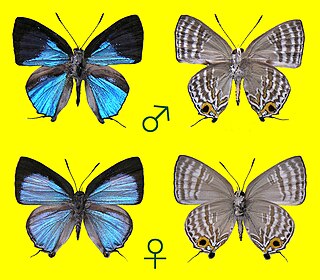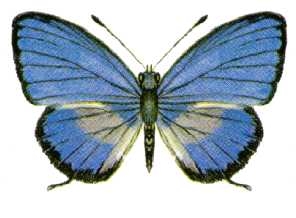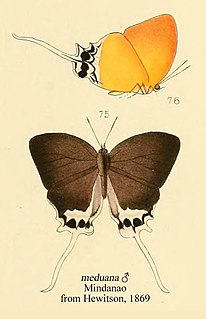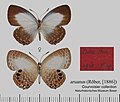
Graphium eurypylus, the great jay or pale green triangle, is a species of tropical butterfly belonging to the family Papilionidae.

Poritia phalena, the broad-banded brilliant, is a small butterfly found in India and South-East Asia that belongs to the lycaenids or blues family. The species was first described by William Chapman Hewitson in 1874.

Jamides, commonly called ceruleans, is a genus of butterflies in the family Lycaenidae. The species of this genus are found in the Indomalayan realm, the Palearctic realm and the Australasian realm.

Sinthusa is a genus of lycaenid butterflies, the sparks. They are small species with the male genitalia and secondary sexual characters of Virachola, but less robust and weaker in flight. The males are easily recognized, with the forewings oily indigo blue changing to shining blue in a side light and hindwings shining violet blue in all lights. The species of this genus are found in the Indomalayan realm. The genus was erected by Frederic Moore in 1884.

Poritia is a genus of lycaenid butterflies. The species of this genus are found in the Indomalayan realm. Poritia was erected by Frederic Moore in 1887.

Arhopala centaurus, the centaur oakblue or dull oakblue, is a species of lycaenid or blue butterfly found in India and southeast Asia to the Philippines.

Dacalana is a genus of butterflies in the family Lycaenidae. The genus is distributed from Assam through Sundaland to Sulawesi, and is especially richly represented in the Philippines.

Deramas is a genus of butterflies in the family Lycaenidae erected by William Lucas Distant in 1886. The genus ranges from south Myanmar to Sundaland, the Philippines and Sulawesi. Most of the species are rare and endangered, and are confined to forest from sea level to about 5,000 feet (1,500 m).

Drupadia is a butterfly genus in the family Lycaenidae. They are commonly known as posies. The members (species) of this genus are found in the Indomalayan realm.

Matsutaroa is a butterfly genus in the family Lycaenidae. It is nearest to the genus Ancema, but differs from it in the following points: (1) veins 5 and 6 on the forewing are not very close at their origins, but in Ancema they are very close at their origins; (2) the ground colour of the underside of the male is white, tinged with pale yellow and blue and has no shade of silver, but in the genus Ancema the ground colour of the underside is more or less tinged with silver; (3) in the male genitalia the valva is stout, a short brachial process is separating from the dorsum of the valva, and the phallus is stout, but in Ancema the valva is slender, a long brachial process separating from the ventral direction of valva, and the phallus is very slender.

Tajuria is an Indomalayan genus of butterflies in the family Lycaenidae.

Sinthusa natsumiae is a butterfly of the family Lycaenidae first described by Hisakazu Hayashi in 1979. It is endemic to the Philippines and is found on many islands. It is very beautiful, especially on the forewing upperside of the male, where it has two brilliant blue colours. Its forewing length is about 12–15 mm.

Nacaduba cyanea, the tailed green-banded line-blue, is a species of butterfly in the family Lycaenidae, and formerly considered a member of the genus Danis. It is found in the Indonesia, Papua New Guinea, the Solomon Islands and Australia (Queensland).

Dacalana lucillae is a butterfly of the family Lycaenidae first described by Hisakazu Hayashi, Heinz G. Schroeder and Colin G. Treadaway in 1983. It is found only on Luzon island in the Philippines. The forewing length is 18–19 mm.

Hypothecla astyla is a butterfly in the family Lycaenidae first described by Cajetan Felder and Rudolf Felder in 1862. It is found on the Philippines.

Drupadia ravindra, common name common posy, is a butterfly in the family Lycaenidae.

Euthalia alpheda is an Indomalayan butterfly of the family Nymphalidae (Limenitidinae).

Eooxylides meduana is a butterfly in the family Lycaenidae. It was described by William Chapman Hewitson in 1869. It is found in the Philippines.


























